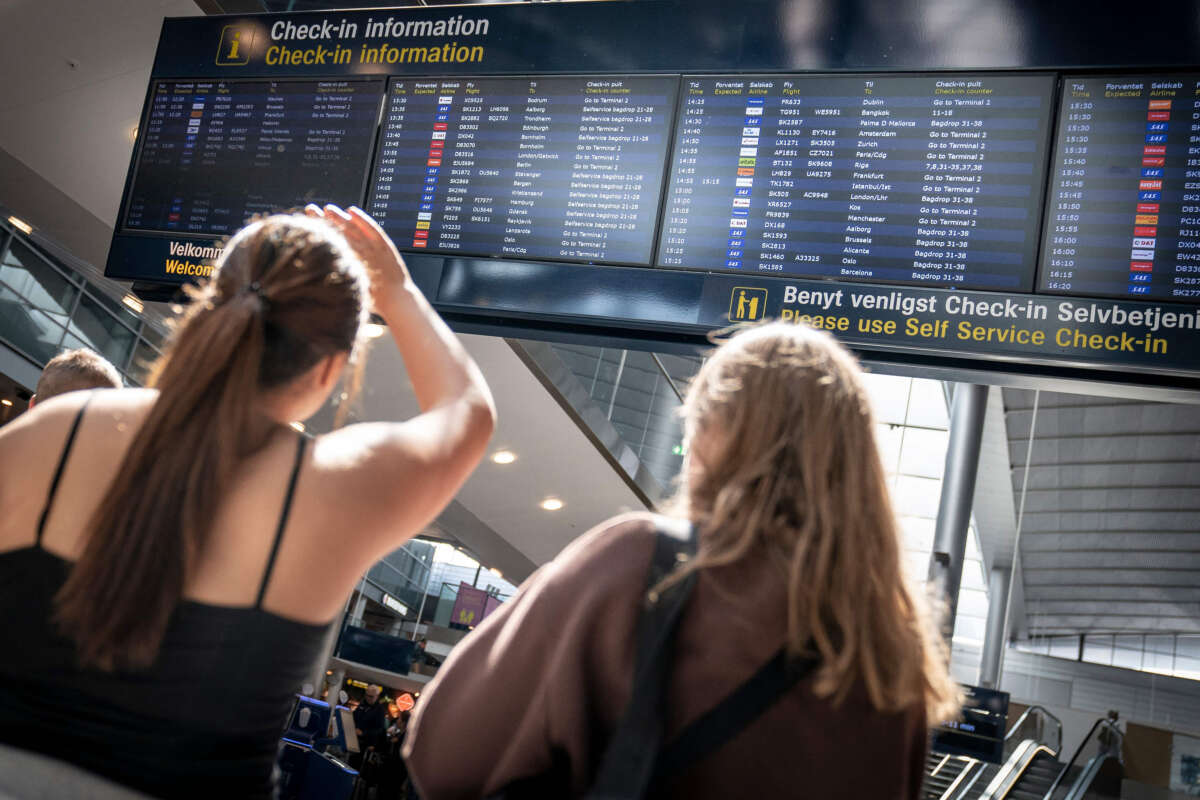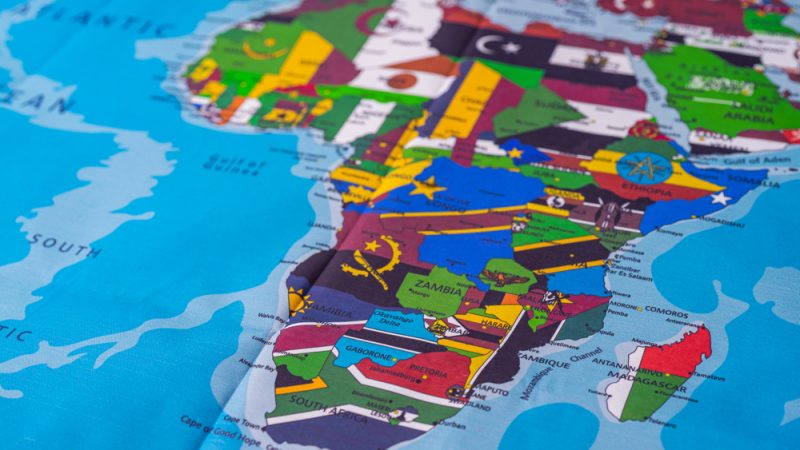(RNS) – 'This is a church of immigrants,' said Pastor Reginald Silencieux of Première Eglise Evangelique Haïtienne in Springfield, Ohio. '... They are very scared.'

Jean-Michel Gisnel cries out while praying with other congregants at the First Haitian Evangelical Church of Springfield, Sunday, January 26, 2025, in Springfield, Ohio. (AP Photo/Luis Andres Henao)
Fiona André
March 28, 2025
(RNS) — Since President Donald Trump took office in January, congregants of the Voice of the Gospel Tabernacle church in the Mattapan neighborhood of Boston have gathered weekly to pray for a miracle.
Members of the Haitian congregation hope God will soften the hearts of the country’s leaders so they will spare immigrants from deportation, said the church’s lead pastor, Bishop Nicolas Homicil.
“We prayed for God to take control of the White House, to change those people who lead the country now, to talk to them, to let them know Jesus himself was a refugee in Egypt,” Homicil said.
But on Tuesday (March 25), the Department of Homeland Security ended a program that allowed more than half a million nationals of Cuba, Haiti, Nicaragua and Venezuela to remain in the country. The DHS notice said the temporary protected status granted to individuals — many of whom entered under a Biden-era humanitarian parole program called CHNV, an acronym for the four countries — would end on April 24. It urged individuals to self-deport or prepare to face arrest after the deadline.
The news sent a shockwave through the Haitian community, as many immigrants who left the Caribbean island stricken by gang violence benefited from the CHNV program. At the Voice of the Gospel Tabernacle church, 30 members came early on Wednesday to fast and pray for the hundreds of thousands of Haitians who face deportation.
Homicil said they chanted a famous Creole anthem for difficult times: “Nan mitan gwo lanmè ak tanpèt mwen te ye/San sekou m te pèdi, San lafwa, san limyè,” which translates to, “I found myself amid terrible waters and storms/ Without help, I was lost, without faith or light.” The congregation also read portions of Psalm 46, as a reminder of God’s presence.

Bishop Nicolas Homicil. (Courtesy photo)
The Trump administration’s enforcement of stricter immigration policies, Homicil said, has resulted in fear for Boston’s vibrant Haitian community — the third largest in the U.S. — and affected religious life. Service attendance started to drop a few weeks after Trump’s inauguration. On Sundays, 300 people usually attended services. About 100 do now, and many Boston-area congregations face the same problem, he said. He recently met with Muslim and Jewish ministers and Mayor Michelle Wu to discuss the issue.
Some worshippers, Homicil said, are afraid to leave their homes because they fear being arrested by immigration agents. As a result, the church’s food pantry, which serves about 250 people, started delivering food packages to homes because some beneficiaries were too afraid to attend church.
Though the DHS notice mentions “self-deportation,” that’s not an option for members of his community, Homicil said. Haiti’s situation is too fragile for them to consider voluntarily going back. In Port-au-Prince, the nation’s capital, armed gangs have gained control of entire neighborhoods and could soon control the entire city. In 2024, 5,600 people were killed due to gang violence, according to the United Nations.
“Everybody is just trembling. Everybody was deceived, everybody lives in uncertainty because they cannot go back home, because back home, there is a legion of gangs who chase them out,” Homicil said.
In January 2023, the Biden administration introduced the CHNV parole program to curb illegal immigration by creating legal routes. About 532,000 people entered the country through the program and were granted Temporary Protected Status, giving them the right to remain legally in the country, to work and to receive travel authorization.
DHS suspended the CHNV program in August 2024 after an internal report revealed possible sponsorship fraud. In October, the Biden administration announced it was not renewing it. Under that ruling, immigrants would face deportation when their two-year parole grants expired if they did not find another legal pathway, but were eligible to apply for other benefits, like asylum and TPS.
The March 25 DHS notice said the CHNV programs didn’t “serve a significant public benefit, are not necessary to reduce levels of illegal immigration, did not sufficiently mitigate the domestic effects of illegal immigration, are not serving their intended purposes, and are inconsistent with the administration’s foreign policy goals.”
The day before, a first hearing was held at the District Court of Massachusetts in Boston for a lawsuit filed by immigrant advocacy groups against Homeland Security Secretary Kristi Noem, challenging the termination of the CHNV program. The lawsuit was filed by 11 beneficiaries, seven sponsors and organizational plaintiff Haitian Bridge Alliance.
The Justice Action Center, which represents the plaintiffs, also filed a motion for preliminary injunction, asking the court to suspend parole termination while the case is being heard. The next hearings are scheduled for April 7 and April 10.
At the Première Eglise Evangelique Haïtienne (First Haitian Evangelical Church) of Springfield, Ohio, congregants meet three times a week to pray for the Trump administration, pleading to God for a solution in favor of the local Haitian immigrant community, said Pastor Reginald Silencieux.
Last summer, the Haitian community of Springfield faced scrutiny and harassment after then-candidate Trump falsely alleged during a presidential debate that members of the community were eating pets in the city. The comments, and then the recent executive orders targeting immigrants, have taken a toll on the community, Silencieux said.

A weekly English Speakers of Other Languages (ESOL) course, primarily attended by Haitian migrants, meets at First Haitian Evangelical Church of Springfield, Sunday, Sept. 15, 2024, in Springfield, Ohio. (RNS photo/Kathryn Post)
“This is a church of immigrants. The executive order really affects them,” he said. “They have psychological problems right now. They are very scared.”
Now, every Sunday when Silencieux looks out at the pews, he sees the effects: the 500-member congregation has considerably shrunk, he said.
As a faith leader, the situation has been overwhelming since January, he said. Many congregants don’t understand why their legal status is being challenged.
“If the system is illegal, we can say, ‘Yes, we are illegal.’ If the system is legal, we are legal because they all went through the system,” Silencieux said.
The Rev. Myrlande DesRosiers, pastor of New England Voice of Hope and Peace Ministries and executive director of the Everett Haitian Community Center in Massachusetts, said the local Haitian community has not only lost its vibrancy but also toned down religious celebrations as fewer people are attending services.

The Rev. Myrlande DesRosiers. (Courtesy photo)
For Lent, the Haitian community reflected on the fragility of life and the events that sometimes shatter one’s faith, DesRosiers said. And local Haitian faith leaders in the community have expressed a desire to dedicate more time to praying about the situation during Sunday services, she said.
“Prayer still works. … When we wholeheartedly cry out to the Lord, He does listen, but we really need to put ourselves together to make it a priority — not just something on the side, just a few minutes, but really concentrate on that and cry out to the Lord,” she said.
DesRosiers also said the situation has taken a toll on faith leaders who lead fearful congregants. “You give pastoral counseling, and you have to deal with the tears, you have to deal with the fears. You have to deal with the sadness that you see,” she said.
RELATED: Christian groups kick off Lent with letters objecting to Trump moves on budget and immigration
The Rev. Manny Daphnis, pastor at Restoration Community Church in Holbrook, Massachusetts, and a member of the Fellowship of Evangelical Haitian Pastors of New England, said his latter organization tries to equip faith leaders with resources to protect worshippers. In light of the immigration policy changes, the fellowship urged churches to designate someone to identify who is entering sanctuaries “so that folks aren’t just welcoming ICE members into the congregation and worship services,” he said.
Meanwhile, as the clock ticks for those who will soon face deportation, Homicil plans to host a legal advice event on Saturday (March 29). The church will also continue its weekly prayer meetings for the Trump administration, he said.
“If God doesn’t intervene, I don’t know how this is going to be,” he said. “But God is in control of everything. Mr. Trump is not God. God is God. He’s the one who is in control.”












